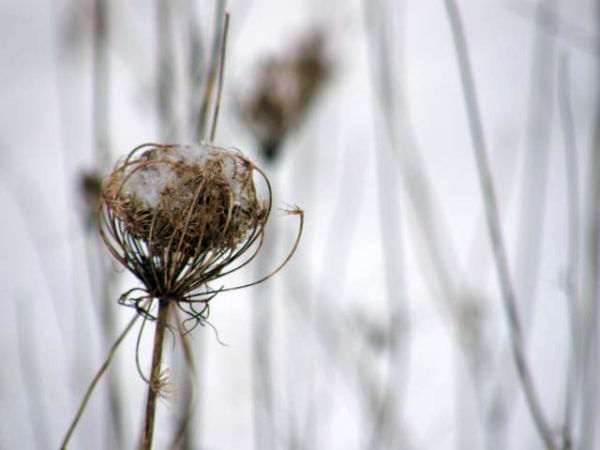
Queen Anne’s Lace (Daucus carota) is easy to find in summer and winter because it grows abundantly in meadows, along roadsides and in waste places.
In winter its umbel flower head curls inward, holding the seeds like a nest inside. The tiny fruits are very interesting. They’re ribbed with rows of bristles and pop open on their long edge. This flower is holding the fruits and some snow as well.
Queen Anne’s Lace is in the Parsley family. Its two to three-foot stems are grooved and slightly hairy and its leaves — if still present — are many-branched and even more finely divided than parsley. If you’ve seen the leaves in summer they remind you of carrot tops and that’s exactly what they are. Daucus carota is the same species as our garden carrot and has a yellowy-white root. We eat carrots in the first year of their biennial life so we never see them flower.
Smell the leaves and you’ll get a whiff of carrots, parsley and parsnips. But be careful. Know your plants before you handle, dig or taste them. Poison Hemlock, the plant that killed Socrates, is also in the Parsley family and resembles Queen Anne’s Lace in many ways.
(photo by Marcy Cunkelman)
When my kids were little (44 and 41 now) they used to bring bunches of Queen Anne’s Lace back to me. I would separate them into 4 different glasses of water to which I had added food coloring and keep some of the white ones out. “Magically” in about 4 minutes the flowers would change color. My sons would get so excited. Then we would put the flowers in one vase with the white ones in the middle.
Merry Christmas everyone and a Blessed New Year!
I’m not fond of Queen Anne’s Lace when it gets into your garden because it seeds like mad and can take over (it’s growing all through my lawn now since I don’t use weed killers on a regular bases). This year I finally figured out what Poison Hemlock was….there was something growing all over the hillside below the office building I work in, and also along the Montour Trail (bike trail). I was wondering if the plant was Cow Parsnip or (a bigger concern) Russian Hogweed, but I after consulting my various native plant references, I decided it was Poison Hemlock. I’m not really fond of any of the plants in the Parsley family since most of them spread pretty aggressively.